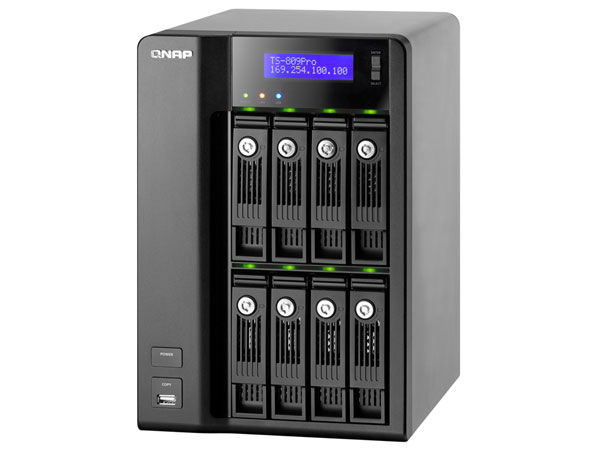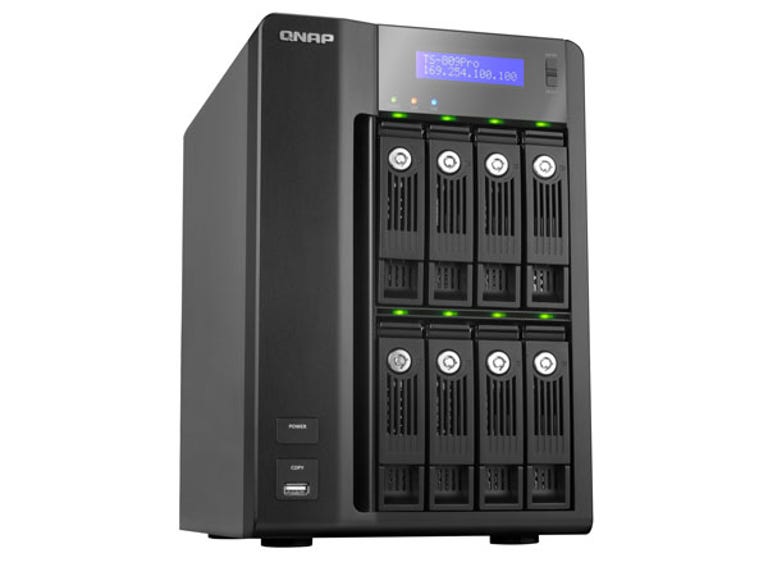 Why You Can Trust CNET
Why You Can Trust CNET QNAP TS-809 Pro review: QNAP TS-809 Pro
We're impressed with the QNAP TS-809 Pro. It's solidly built, excellently featured and a high-level performer. While we'd like to see the Multimedia and Download stations receive more functionality, for most people and small businesses the TS-809 Pro comes as a highly recommended device — providing you can afford it.
Network Attached Storage (NAS) devices can be scary things for the newcomer. With the huge amount of features packed into the blighters, it's often not as simple a case as plugging in a few hard drives and just saying go.
The Good
The Bad
The Bottom Line
Nonetheless, the appeal of having centralised storage without having to worry about setting up network file sharing multiple times is a strong one. Along with media streamers, consoles and TVs that will happily play video straight off your network, those with a teensy bit of tech savvy and more than one PC in the house will realise they need somewhere to store their episodes of ... er ... House.
So those with the easiest NAS to use with the most features wins.
QNAP, for what it's worth, does a pretty good job at this, without making things so simple that you lose options. Its AJAX-heavy web interface is well designed and bristling with configuration pages, but if you follow the tried and true click on the first setting all the way to the last, you'll soon have your NAS set up to your heart's desire.
The hardware
The TS-809 Pro uses this very interface, and does it with eight 3.5-inch drive bays to boot. These can be configured in single drive, RAID 0, 1, 5, 6 or JBOD, and QNAP supplies excellent volume configuration tools and scheduled SMART checking capability. It even offers full volume encryption for the security conscious.

The QNAP TS-809 Pro. As far as prosumer NAS goes, this is the new king. (Credit: QNAP)
Running off a Core 2 Duo clocked at 2.8GHz with 2GB RAM, it's no slouch either. It's got dual-gigabit Ethernet ports (capable of multiple load balancing, fail over and teaming configurations), runs off a 128MB DOM, has five USB ports (one at the front, four at the back — supporting external drives, printers and UPS devices) and an LCD status screen that is a step up from the TS-509. There's a one-touch USB backup button (which will suck data from a USB drive into a predefined directory onto the NAS) and a power button on the front, and each drive has individual status lights. eSATA support is curiously absent.
As far as NAS goes, it's rather gorgeous, if you're into this sort of thing.
Interface and feature overkill
We used firmware 3.2.6 for this review — it's important to note this, as firmware revisions on NAS units can update feature sets and interface design radically.
Pointing the web browser at the NAS's IP, we were greeted with a Cover Flow-style menu giving access to the Administration menu, web-based file browser, and links to customer service, the QNAP wiki and QNAP forum. We've said it before — while this is pretty, it's useless, and adds an extra step before you get to the actual configuration of the NAS.
Pretty, but unneeded. All these links already exist in the administration section. (Screenshot by Craig Simms/CNET Australia)
As far as feature overload is concerned, the TS-809 Pro has it, making a serious argument against building your own file server. It supports SSH, telnet, SMB, AFP, NFS, FTP, SNMP, UPnP and Bonjour protocols, as well as supporting SSL connections with certificates. It has an SMTP server built in for mail alerts, and an SMSC server too, allowing SMS alerts to be sent should the unit have a problem. The latter isn't free, but instead pipes through Clickatell's service — which offers decent SMS costs. It could be a life saver if you've chosen to deploy this in a business situation.
The TS-809 Pro is aimed at business users too, so it's no surprise to find iSCSI here, and its Virtual Disk feature allows you to mount other iSCSI targets as if they were drives on the QNAP NAS itself. Something potentially also of interest to business users is the network recycle bin — that one extra level of protection before you have to hit the tape servers for long-lost backups.
The staples of user/group management and access control are here, supported with access logs. It also has a built-in web server with MySQL and PHP support, along with support for six different dynamic DNS services. Media support is handled by Twonky, and it also packs an iTunes server.
You can control the dual 120mm fans manually to optimise for silence or performance, set Wake on LAN, power on/off scheduling, set the device's behaviour if it unintentionally loses power (whether it powers on or off afterwards, or remembers its previous state), and view any number of stats from CPU usage down to the temperature of various components.
Backup options are exhaustive too; you can run scheduled backups using Rsync or to your Amazon S3 service, it supports Apple's Time Machine, it'll copy set folders to an external drive whenever it's plugged in or alternatively will copy data from a USB drive to a predefined directory if it's plugged in the front USB port.
As with previous QNAP NAS devices, the remaining functionality is broken into a number of "Stations". Not much has happened with the Multimedia Station since we last looked at it — despite being able to identify several media types, it can only really be used for remotely viewing and identifying images. It can plug into Cooliris, but is otherwise of limited application, not handling song previews or even movie thumbnails.
The only real use of the Multimedia Station is to identify images remotely — it doesn't do song previews or movie thumbnails. (Screenshot by Craig Simms/CNET Australia)
Much more useful is the Download Station, which can run BitTorrent, HTTP and FTP downloads, and schedule these downloads to run only between specific hours.
The Download Station lets your NAS run your BitTorrent, HTTP and FTP downloads, letting you switch off your own PC when it's not being used. (Screenshot by Craig Simms/CNET Australia)
If you happen to use IP cams you can also use QNAP's Surveillance Station — although we had no IP cams on hand to test this functionality.
If this wasn't enough for you, the functionality can be extended through QNAP's QPKG plug-in system, adding support for SqueezeBox, WordPress, news group downloads and more. QNAP's forums are also active, meaning support isn't too far away.
Performance
Being Core 2 Duo based and with 2GB RAM, the TS-809 Pro is at the top end of prosumer NAS — consequently we expected good performance, and we weren't disappointed. Using a 1GB test file over SMB, we were treated to maximum speeds of 122MB/s from the NAS, and 92.7MB/s to it, with performance generally settling around the 73MB/s mark.
FTP provided a speed boost, with maximum speeds of 180MB/s recorded from the NAS, and 130MB/s to it, with performance once again settling down to the 73MB/s mark. These maximums of course exceed gigabit Ethernet's theoretical speed of 125MB/s (which shouldn't be reachable due to overheads), so we can only guess some odd caching is going on here.
We're impressed with the QNAP TS-809 Pro. It's solidly built, excellently featured and a high-level performer. While we'd like to see the Multimedia and Download stations receive more functionality, for most people and small businesses the TS-809 Pro comes as a highly recommended device — providing you can afford it.


